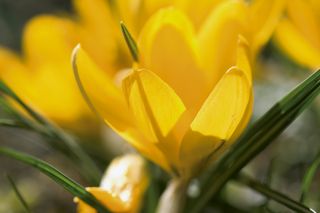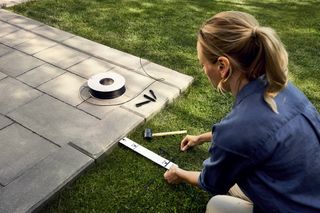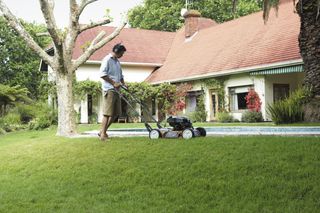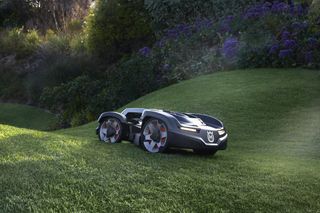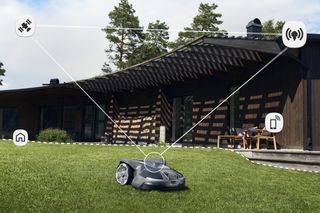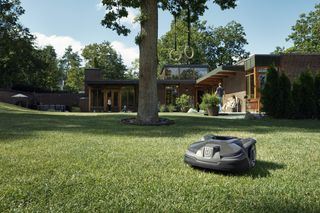HUSQVARNA’S TIP: Use one of Husqvarna’s robotic lawnmowers to maintain a short meadow. To achieve this, set Automower® to the highest level – 9 (i.e. a mowing height of up to 6 cm). This gives lower lying plants like clover and daisies the chance to bloom at a lower level, creating a short meadow.
You can also section off a part of your garden from the mower with a boundary wire to create a flower meadow, ideally with a mixture of native meadow flowers. The advantage to this is that, unlike with hand-mown areas, the meadow stays in the same place and flowers can reseed themselves there every year.
Bee-friendly garden
The welfare of bees and other insects is important to many people. So we put together eight helpful tips for you to make your garden bee and insect-friendly.
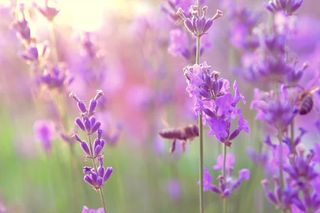
The welfare of bees and other insects is important to many people. So we put together eight helpful tips for you to make your garden bee and insect-friendly.
Tips for a bee-friendly garden
The welfare of bees and other insects is very important to many people. So we had an in-depth discussion with our partner, Bienenbotschaft (Bee Embassy), and have put together eight helpful tips and interesting background information for you to make your garden, terrace or even balcony bee and insect-friendly.
Important: When designing your garden, don’t just think of the bees but all insects in general. After all, the primary value of these animals lies in pollination, not honey production.
1. Feed the bees all year round
"When choosing plants for your garden and terrace, use native plants wherever possible since wild bee species will have adapted to local food plants,"" explains Moses from Bienenbotschaft. A wild species is always preferable to a cultivated species of plant. Avoid double flowers – they look nice, but having so many petals acts as a barrier between bees and nectar and pollen, making them pretty worthless as food. Instead, choose a mix of plants farmed organically that flower all year round and provide insects with food. Bees will thank you for providing such an abundant food supply, especially at the beginning and end of the vegetation period, i.e. spring and autumn. The plants below are particularly well suited:

2. Meadow or lawn?
Every gardener should ask themselves, ‘Would I prefer a meadow with beneficial weeds or a green lawn?’ There are strong arguments for both. On larger plots in particular, an extensive, well-tended meadow requires less mowing and provides a valuable habitat for wild animals. However, many families want a lawn without any clovers and other intruders so their children can romp around barefoot in the garden without being stung.

3. Bee-friendly trees, hedges and shrubs
Hedges, shrubs and trees are not only an important source of food, especially in cities, but also provide hiding and nesting places for numerous insect species,” reveals Antonio from Bienenbotschaft. So (different) individual bushes should be allowed to grow freely in select places and bear flowers and fruit, even in small gardens. Here too, a mixture of different varieties is ideal so that insects can find food throughout every season.
These shrubs are especially good for bees: Cornelian cherry (Cornus mas), hawthorn (Crataegus) and wild rosebushes. When it comes to trees, try pussy willows (Salix caprea), fruit trees like wild cherry or apple and (although not native) bee-bee trees (Euodia hupehensis).

4. It doesn't always need to be a huge meadow: spiral beds and 'wild corners'
Fragrant, tasty and, according to Bienenbotschaft, a real asset not only for bees and for us alike: spiral beds planted with herbs like sage, marjoram, thyme and the like offer a lot of food for insects. And they feed the bees all year round: rosemary blooms in spring, sage in the summer months, nasturtium even into September and thyme flowers up to October. In addition, the numerous holes, cracks and cavities found in these kinds of beds make for good insect nurseries for rearing offspring.
Insects will also thank you for your courage in planting a ‘wild corner’ in your garden: from stone and deadwood heaps to ivy-covered walls – they all provide a habitat and shelter for many insect and spider species, reptiles, amphibians, birds and small mammals. Between spring and summer, some species of wild bees lay their eggs in existing or self-drilled holes in woody structures or in stalks. If you want to help these bees, you can also heap deadwood inconspicuously under bushes.

5. Bee and insect food on balconies and terraces
It’s easy to transform terraces and balconies into a bee paradise with flower tubs or boxes as well. Bluebeard (Caryopteris) is particularly well suited for this. More tips for plant pots that are extra bee-friendly:
- Late flowering mixture with flowers blooming until October: marigold, snapdragon and nasturtium.
- Herb/flower combination: lemon balm and thyme with bellflower or Tagetes marigolds.
- For nibbling and bee-watching: strawberry, aubergine, peppers or chillies or potted tomatoes.
- Fragrant herb pots: English lavender, sage, lemon thyme and oregano.

6. Nesting aids for bees
In addition to suitable plants, nesting aids within a radius of 200 to 300 metres from the plants the bees use for foraging are essential for wild bees. Unfortunately, many of the wild bee nesting aids on the market do not deliver the benefits consumers want because they are made of unsuitable materials or are not constructed in the right way. The wild corners, old walls and piles of deadwood mentioned above are often already in place to help bees.
In addition to suitable plants, nesting aids within a radius of 200 to 300 metres from the plants the bees use for foraging are essential for wild bees. Unfortunately, many of the wild bee nesting aids on the market do not deliver the benefits consumers want because they are made of unsuitable materials or are not constructed in the right way. The wild corners, old walls and piles of deadwood mentioned above are often already in place to help bees.
Bienenbotschaft has worked with researchers to create the perfect natural home for bees: the natural habeetat® log hive, updated in line with Zeidler beekeeping principles. The hive is made by making a cavity in a tree trunk to provide bees and other insects with a species-appropriate habitat. Bees housed in this manner are not used to farm honey but are left to live their best bee lives as healthy and undisturbed as possible.
7. Don't forget the drinks
Even insects need to drink. Small coves in large stones or bird baths with a large stone placed in them and filled with water on sunny days make great places for bees to come for a drink. And garden ponds also make great water sources for many animals and insects, of course. By the way, did you know that many wild bees need water not only to drink, but primarily to build their nests? They use the water to ‘mortar’ their brood cells.
8. No pesticides
Those who prefer more natural garden landscapes tend to avoid pesticides and artificial fertilisers. There are almost always good, natural alternatives. The use of beneficial insects to combat pests has been tried and tested, and these insects can now be ordered easily and cheaply online. In case of doubt, removing or trimming diseased plants or plants infested with pests is also a better alternative in bee-friendly gardens.
HUSQVARNA’S TIP: Thanks to its battery-powered drive, Automower® not only mows quietly and with no direct emissions, but its mowing system also reduces the need for fertiliser and other products. Millimetre-fine grass clippings are immediately returned to the lawn as fertiliser. The mowing system, comprised of a mowing disc and small pivoting blades, generates hardly any suction, reducing the risk of insects on the ground being sucked up.
By combining different bee-friendly garden approaches, each and every home gardener can do their part to ensure the welfare of our precious bees.
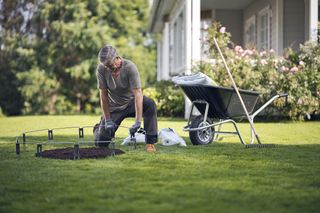
Be kind to bees and save flowers with Automower® Temporary Fence
These robust steel arches offer the ideal solution when you need to temporarily fence off a certain lawn area from being mowed by Automower®. Such occasions as, when the spring flowers are blooming, or when the kids’ inflatable summer pool is in use, or when you have a spot with freshly sown grass. The fencing arches are reliable and extremely easy to use – no need for adjustments of your installation or robotic mower schedule.
